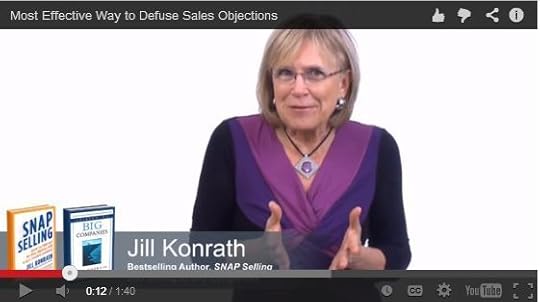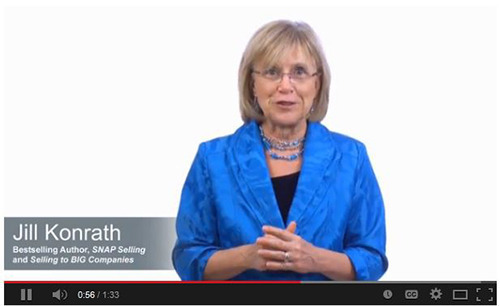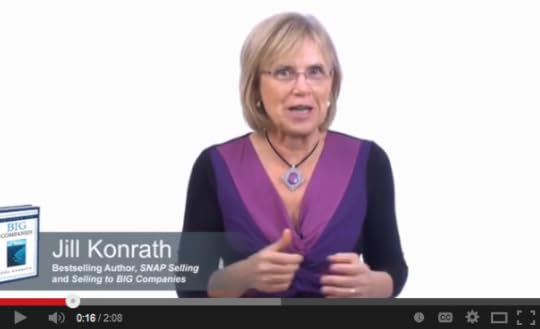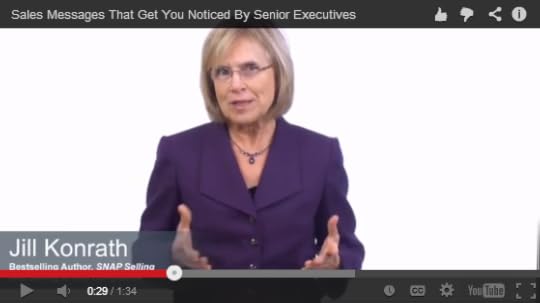Jill Konrath's Blog, page 22
February 27, 2014
Jolt Your Prospects to Get Their Attention
As I write this, I’m flying home (via Delta) from a speaking engagement in Orlando. I fly a lot; it’s part of my business.
When the flight attendants give their safety overview, I never pay attention. I could practically do it by heart myself. Same for the video that cover these details. Boring.
So why am I glued to the screen today paying rapt attention?
Delta has jolted me out of my normal routine. In the video, I didn’t see mundane passengers following the flight attendant’s directives.
Instead, I saw a scruffy looking character refuse to help with emergency row procedures. When he got up to leave, he was replaced by an acrobatic guy doing a flip in the aisle.
The video then returned to the flight attendant who admonished us about smoking. But quickly cut to a cute little girl shaking her finger at the screen, to emphasize the point.
The cast of exaggerated characters (old grannies, hipsters, dweebs and more) continued throughout.

I watched the whole thing. And, this is the second time I’ve seen it this week. All around me people are watching it – and smiling. Clearly this approach is working.
How does this relate to you? When you’re selling, one of your key challenges is to capture and keep a prospect’s attention. If you sound like every other sales rep out there, you’ll be ignored.
So ask yourself these questions:
How can I jolt prospects out of their usual behavior?
What can I do that’s unexpected?
How can I leverage humor?
Take a look at your messaging. Analyze what you do in your initial sales conversation. Then start experimenting.
Most of all, have fun!






February 25, 2014
Why Half-Baked Ideas Are Perfect Sales Conversation Starters
 It happened again last week. I was speaking at a sales kickoff meeting, stressing a key message—that sellers, not their products or services, are the key differentiator today. I said,
It happened again last week. I was speaking at a sales kickoff meeting, stressing a key message—that sellers, not their products or services, are the key differentiator today. I said,
"Be an idea person. Today’s crazy-busy prospects love it when you bring them ideas on how to improve their business."
That’s when the hand popped up. It always does. In a group of salespeople, there’s always someone who’s brave enough to ask the question that’s on everyone’s mind.
"How can you bring them ideas when you’ve never met before and have no clue if they’d work?"
Sounds legitimate, right? After all, every customer is unique. And, we want to be consultative. So it would be almost criminal to pitch an idea before we fully understand their needs.
Besides, the thinking continues, our ideas need to be well thought out and fully formed. If we went in with a half-baked idea, it would destroy our credibility.
WRONG! Those are faulty assumptions that are totally off base and may be hindering your ability to start sales conversations. Here’s why:
Every prospect is not unique.
Virtually every Sales VP is concerned about meeting their numbers, every HR executive worries about rising health care costs and every purchasing agent wants to reduce costs.
If you target specific industries, you’ll find virtually every organization in that market segment is concerned with emerging trends that could shape their future.
People are curious how others handle similar challenges.
The truth is, your prospects don’t get out a lot. They don’t have a lot of chance to interact with others who hold similar positions; they’re too busy doing the work.
If you can bring them ideas on how companies approach the problems they face or reach hard-to-achieve objectives, they’re interested. This is high value information.
Ideas are not promises.
Instead, they get people thinking about new options they’d never considered before. Even half-baked ideas stimulate new lines of thought or fresh approaches to tough challenges.
The key is to present them as ideas, not the perfect solution. When you do that, you create an opportunity to talk about what your prospects are currently doing, the issues they're facing, what they’ve tried and how your ideas impacted other companies.
Even if your ideas won’t work for their organization, you’ve differentiated yourself from competitors and established yourself as a valuable resource. Here’s a quick example. Say I called you and said this:
“Hi. Jill Konrath here. Most sellers I know really struggle to set up meetings with new prospects. I’ve got some ideas that have worked real well for others in your industry.
One client achieved an 87% success rate getting into major accounts. If this is of interest, let’s set up a time to talk.”
Would you be interested? Even if my idea didn’t turn out to be an ideal fit for your company?
Perfection isn’t what it’s cracked up to be. Often times a half-baked idea is what’s needed to start the sales conversation.






February 18, 2014
Two Ideas for Breaking Through Sales Barriers
 Recently I was approached by a salesperson who was facing a tough challenge. When he gets his targeted buyers on the line he frequently has to deal with these sales objections:
Recently I was approached by a salesperson who was facing a tough challenge. When he gets his targeted buyers on the line he frequently has to deal with these sales objections:
"We recognize your proven credentials but aren't taking on any new suppliers."
"Great stuff, but we're already getting this from another vendor."
He wanted to know how he could break through these sales barriers. Here are the two suggestions I gave him:
1. Analyze what you're saying.
You're probably talking about your product/service way too early. The reason I say that is because the response you’re getting is a common reaction to that.
To solve this problem, you need to rethink your entire conversation. What would it take to get them to say, “Mmmm. These guys really get the challenges we’re facing. They have some good ideas that could help us achieve our objectives. Maybe we should talk with them more.”
It's likely you need to do more research/prep prior to calling so you can customize your message to their situation.
Also, think about sharing a case study at the start of your conversation to give your prospect an idea about how you help others achieve their goals.
Finally, be prepared with a question about their objectives and challenges.
2. Be a bit more nicely brazen.
If you’ve done the above (which I sincerely believe needs some serious examination), then you are allowing yourself to be brushed off too easily. I’ve often found that it works well to say something like this:
“Listen, John. Based on what we’ve talked about, it’s highly likely that we could save your company XXX in 2014, at the same time we improve XXX. You’re not getting that from your current suppliers. So, what do we need to do to get on your approved vendor list.”
That's not being rude. It's being confident in the results you deliver. And, you can do it with great sincerity when you know that what you sell truly does make a difference.
By changing what you say and not backing down so quickly like a wuss, you will get different results.
Your Turn: That's my two cents! What other advice would you offer this struggling salesperson?






February 13, 2014
[Video] Best Way to Defuse Dreaded Sales Objections
If you’re like me, you dread talking about certain things with your prospects because they’ve always caused you problems. But, deep inside you know that it's just a matter of time before you get asked about it – and then you’ll stumble through a lame response that makes you sound like a total loser.
So what should you do in these situations?
You have to be willing to raise the sales objections yourself.
And, before you do that, you need figure out what you’re going to say. You might even need to experiment with different versions before you find a response that works.
For example: pricing. If it’s always a sales objection, then you’ll want to address it early on. Ask your prospects if it’s the key factor in their decision. They’ll probably say it’s important but not the only thing. That’s when you say, “That’s good because we’re not the lowest cost provider and there’s good reason for it.” Of course, you’ll need to be able to clearly articulate your value too.
Another example: Say you’re a small company competing against the giants. It’s something you can’t change, so you need to deal with it. Bring it up early – and then talk about what you offer instead. More personalized service. Faster responsiveness. More customization. There are benefits of being small. It’s your job to convey them.
So what are the elephants in the room that you’re tiptoeing around? What areas do you dread talking about?
Once you identify your most common sales objections, start working on how to proactively bring them up when you meet with prospective customers.
That's they only way for them to lose their impact!







February 11, 2014
Don’t Make These 3 Video Meeting Mistakes
 If you’re not using video meetings to connect with prospects and clients, you’re wasting tons of time. There’s no reason to spend hours driving to and from sales meetings anymore.
If you’re not using video meetings to connect with prospects and clients, you’re wasting tons of time. There’s no reason to spend hours driving to and from sales meetings anymore.
Just open up a browser, log onto an online meeting site (ala GoToMeeting) and send the link info to who you want to talk with. Voila! You’re connected.
Using video makes it even better. You can quickly establish personal relationships with new people at a much deeper level. And, with ongoing relationships, it keeps the momentum going.
That’s the good news. But … there’s always a but … doing it well requires mastery of new skills. Believe me, I’ve made a ton of mistakes in the process. Here are a just a few:
Mistake #1: Technology Screw Ups
If you’re like me, using new technology is not second nature. I freak out when things go wrong. To ensure that doesn’t happen, I practice ahead of time with safe people who will still love me even when I’m a total loser. Or, I rope in a savvy geek to give me step-by-step instructions.
Make your mistakes before you go live – or risk embarrassing yourself.
Mistake #2: Unwanted Interruptions
After my husband barged into my home office during an important online meeting, I realized I needed to do something. Today, my office has a huge “Do Not Interrupt” sign outside it when I’m online.
Make sure you shut down text message and email too. I’ve heard horror stories about what’s popped up at a most inopportune time.
Mistake #3: Inappropriate Looks
If you’re using video meetings to create a personal connection, then doggone it, you need to be looking people in the eye. Obvious, yes. But when you’re talking to someone online, I’ll bet you’re looking at where their video shows up on your screen -- which may be in the lower corner.
Make sure to move their smiling face right up under your camera. That way you’ll be looking directly at them – not at their navels.
If you haven’t tried using online video meetings yet, it’s time to get started. Yes, it’s not easy doing something new. But, I can assure you that it’s worth feeling awkward for a short while in order to realize the massive benefits.
----
Got some advice for others? If so, we'd love to hear your take on mistakes to avoid as well as how to make sure things go well.






February 6, 2014
[Video] You'll Never Close Deals Calling on Powerless People
If you're tired of calling on people who really want to work with you, but can't seem to get anything approved, listen up! Spending one more day working with these really nice individuals is a total waste of your time - even though they love you and what you're selling. You'll never close deals that way.
If you want to get the business, you need to find those individuals in the company who are making things happen. CEB, a sales research group, calls these people the Mobilizers. They're the ones who spearhead new projects in their organization. They can see into the future and know that change is imperative for the company - and for them personally.
They jump into action when they see problems that need solving or goals that can't be achieved unless something is changed. They go online to research what's out there. They talk to people both internally and externally to learn more. And, they catalyze people into action.
That's who you're looking for today. A mobilizer. They feel really different than those nice, but powerless people you're talking to now. And, they'll make you feel really uncomfortable too - because they're asking you things that you don't know the answer to. Or, they're challenging what you say. If you're squirming, it's a good sign.
So get going - and find those movers-and-shakers who mobilize their organization to take action. You'll close deals a whole lot faster!






January 30, 2014
[Video] Big Whopper of a Sales Mistake I Only Made Once
Ever made a big whopper of a sales mistake? I sure have! Let me just share one.
When I began selling at Xerox, one of the first things we had to do was to memorize a demonstration script that included everything you needed to know about using a copier. We had to learn it perfectly before we were allowed to make sales calls.
Many years later, I still remember how it started: "Mr. Prospect, for years Xerox has designed copiers to satisfy the needs and requirements of all our customers. Our experience and success in the marketplace has shown that regardless of specific needs, four basic criteria that need to be met – quality, ease of operation, reliability and flexibility.” Not bad, huh!
It took me a long time to memorize it verbatim. But I did. I practiced and practiced. I drove in the car with the script in front of me on the steering wheel. I tape recorded [my speech] as I was driving along.
And finally, I was able to pass the test with my boss. "Mr. Prospect, for years Xerox has designed copiers.... Mr. Prospect, is there any other concerns you have. Mr. Prospect, does that seem easy enough?" And I went through it flawlessly. Which was great because I was finally released to go out to the real world and start cold-calling.
And very shortly after this I schedule my first real demonstration. I was so ready. When he came in, I gave perhaps the best demonstration of my entire life. I nailed that script! At the end, I asked if he had any questions. And he turned to me and he said, "Jill, my name is not 'Mr. Prospect.'"
Now I don't remember if he ever bought that copier or not; all I know is that I was so embarrassed that I called him "Mr. Prospect" that I never made that mistake again.







January 28, 2014
Are You an Unintentional Sales Wuss?

I’m sure your answer is a resounding “no.” But in reality, it’s not what you think that counts. Only your prospect’s perceptions matter—and they can be very different from what you’d imagine.
Why? Because they’re extremely busy. Every time they talk with you, read your emails or meet with you, they’re asking, questions like:
“Is this person a credible resource?
“Does he/she bring a depth of expertise?
“Is this worth my time to continue the conversation?”
So let’s take a look at one scenario to see how your best intentions might be totally misinterpreted.
You’ve finally lined up a meeting with an important prospect. As you’re ushered into their office, you extend your hand and say, “Thanks so much for meeting with me today, Terry. I really appreciate your time.”
You think you’re being courteous. After all, this person is busy and it’s taken a long time to get on their calendar.
They think you’re a wuss. Important people never position themselves as a supplicant, grateful for the opportunity to meet with Mr/Ms. Big. Instead of sounding like the pro you are, you sound like a hopeful wannabe.
Nice people are the worst offenders. They don’t realize that their graciousness and gratitude come across as neediness. Or hopefulness. And ultimately, as being wussy.
What’s a better way to kick off the meeting? Extend your hand and say something like this: “Good to meet with you, Terry. As I said when we set this up, I’ve got some ideas that can help you out with [fill in the business reason].
Notice how that positions you as a peer who’s worth meeting? It’s a totally different framework to begin your conversation. Also, please note that it’s not about your product or service. That makes you seem like a self-serving salesperson. Again, that’s bad.
You have to think to be good at sales—and not just from your own perspective. Review everything through your prospect’s eyes and ask: Do I sound like a valuable resource and a business peer? Or, do I sound like a wuss?
---
Your Turn: What other ways do salespeople sound like a wuss? And, how can they change things?






January 22, 2014
[Video] Sales Messages That Get You Noticed By Senior Executives
If you really want to capture your prospect’s attention, you need a sales message that piques their curiosity and gets them to sit up and take notice. And, if you’re selling to a senior executive today, you’ve only got 30 seconds to make that happen – or you’re dismissed as not worth talking to.
But what are those attention grabbers? The best ones are industry or marketplace statistics that are relevant to your prospect – and related to what you sell.
For example, for many years I used this one to initiative a conversations with VP's of Sales: Are you aware that 75% of Sales VP's say that the root cause of their new product’s failure was a weak value proposition?
Today I could say, “Did you know that a prospect is over 60% of the way through their decision process before they contact your company?” Or, I might say, “Research shows that your salespeople are 5X more likely to get a call returned if they have a personal connection.”
My prospects are interested in these things. And, I have services in these areas.
But how about you? Do you have industry research you can use? Do you enough? If not, get online right away and start looking. Using data from an external resource not only validates what you do – it grabs your prospect’s attention.
Download the Value Proposition Kit for more help creating attractive sales messaging.






January 19, 2014
Pick Up the Damn Phone — or Suffer the Consequences
According to Joanne Black, author of Pick Up the Damn Phone, too many sellers are hiding behind their computers, expecting to get business. After hearing that bold statement, I knew I needed to share her thinking with you. Check out my interview below.
(Note: Click here to download two free chapters of this excellent new book.)
JILL: Wow. Pick Up the Damn Phone: How People, Not Technology Seal the Deal is quite a book title. Sounds like it's a pet peeve of yours. Do you have something against technology?
Joanne Black: Technology addiction is taking over our personal and business lives. Everyone is too busy conversing online to have real, meaningful conversations with the people right in front of them.
Technology can be a great tool; salespeople can begin their relationships and connections on social media. The not so good news is that too many salespeople think technology can do their jobs for them, and that they don't have to talk to anyone.
Let's focus in on social media like LinkedIn, Twitter, blogs, and Facebook. You don't think they're worthless -- or do you?
Joanne Black: Social-selling tools are great for research, identifying trigger events, and finding mutual connections.
But even if you gather all the social intelligence available on a prospect, that information isn’t going to give you much of an advantage over your competitors, who have access to the same tools and information.
What will differentiate you from the rest and get you in front of the decision-maker hasn't changed a bit; it's still a personal connection and a referral from someone the client trusts.
And you don't think that social media is good for getting referrals?
Joanne Black: No. It’s not the place to ask for referrals. Once you’ve identified a common connection to a prospect, reach out to your contact and have a real conversation. Find out how they know the person you want to meet and ask for an introduction.
It's not social intelligence we need; it's relationship intelligence.
Use technology, but don't rely on it to make sales. Pick up the damn phone and talk to your prospects and clients! If you don’t, someone else will.
You define “cold calling” as reaching out to someone who doesn't know you and isn't expecting your call. How has that definition changed in the days of social media?
Joanne Black: The definition hasn’t changed. Unless you know the prospect or have a referral introduction from someone that person knows and trusts, you’re cold calling.
What has changed is the way salespeople now delude themselves. With social media, there’s a new version of what I call the “warm call fantasy.” It goes something like this:
You’ve done your research about your prospects on social media and maybe even identified a common LinkedIn connection or two. Then you send emails making the business case for why your prospects should talk to you. You really believe you’re not cold calling, because you know all about your prospects and ”know” the same people. Your outreach isn't cold, right?
Wrong! There’s no such thing as a warm email, a warm phone call, or even a warm knock on the door. Unless you have a referral introduction, you’re cold calling. And cold prospects really don't want to hear from you.
In Pick Up the Damn Phone!, you stress the importance of face-to-face communication. What counts as face-to-face?
Joanne Black: Any connection you make when you're not typing. You can pick up the phone, use your webcam, or (gulp) actually meet in person. Drive your car, take a train, or get on an airplane—whatever it takes to make connections that count.
Get face-to-face with every major client or prospect, and you won’t have to worry about making quota anymore. You’ll have a rich referral network that keeps your pipeline full of qualified leads.
Bottom line: People do business with people, not with technology. And that isn’t going to change anytime soon.
What advice would you give to senior marketing and sales executives for the coming months?
Joanne Black: I'd first say that they need to avoid pounding their team with numbers, numbers, numbers. Everyone can sense desperation. And they should do these things as well:
Stop the cold emails and cold calls—mindless activities that don't build relationships or close deals.
Make sure your sales teams know how to have executive-level conversations. Don't just give them a phone, a list, and a password and have them go at it.
Focus on the activities that matter. Don't get sucked into the digital snake-oil universe. Make connections that count.
Recently Eric Schmidt, executive chairman of Google, told the 2012 graduating class of Boston University: "Take one hour a day and turn that thing off. Take your eyes off that screen and look into the eyes of the person you love. Have a conversation, a real conversation."
I challenge all salespeople to do the same.
Do you have any final words of wisdom?
Joanne Black: Never stop nurturing your referral network. Referral selling is the only business-development strategy that converts prospects into clients more than 50 percent of the time. So keep in touch, keep those relationships strong, and ask for referrals. Bottom line: If you don’t ask, you don’t get.
Thanks a million, Joanne. And, readers: Click here to read a preview of Pick Up the Damn Phone!. Or, you can go right to Amazon or Barnes & Noble to get a paperback or digital (Kindle or Nook) version of this book.
About Joanne Black
 Joanne Black is America’s leading authority on referral selling—the only business-development strategy proven to convert prospects into clients more than 50 percent of the time.
Joanne Black is America’s leading authority on referral selling—the only business-development strategy proven to convert prospects into clients more than 50 percent of the time.
Joanne helps salespeople and business owners build their referral networks, attract more business and ace out the competition. She's the author of NO MORE COLD CALLING™ and Pick Up the Damn Phone!
To learn more, visit www.NoMoreColdCalling.comhttp://www.nomorecoldcalling.com/ or call 415-461-8763.
Plus, get your copy of Pick Up the Damn Phone!: How People, Not Technology, Seal the Deal on Amazon and at Barnes & Noble. Or get the digital version for your Kindle or Nook.






Jill Konrath's Blog
- Jill Konrath's profile
- 28 followers





